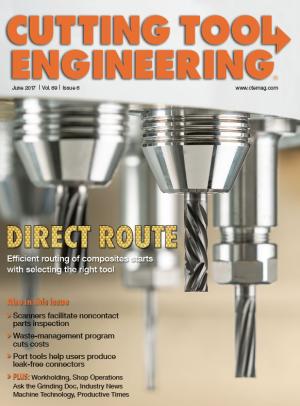Without a doubt, cutting tools for machining titanium must be well-engineered. This was reinforced for me while attending Horn Technology Days 2017, held May 10 to 12 at Hartmetall-Werkzeugfabrik Paul Horn GmbH, Tübingen, Germany.
The event featured eight presentations about the toolmaker’s technological developments. In addition, the 3,000-plus attendees could tour several production facilities, in which Horn has invested more than $76 million during the previous year. The event’s motto was “A glimpse into the future” and, as board member Andreas Vollmer emphasized during a press conference, the company believes in the future.
Vollmer pointed out that machining titanium is becoming a big topic at Horn. This is primarily because of a fivefold increase in the consumption of titanium worldwide during the past 20 years, to a current level of around 330,000 tons, according to the company. However, there are drawbacks that must be overcome when machining titanium. For example, it is susceptible to the detrimental effect of strain hardening when being cut, and sharp cutting edges, correct machining parameters and optimal chip formation are essential. Also, the hardness of the tools and the heat resistance of their coatings must be appropriate because the metal is such a poor conductor of heat.
In a presentation titled “Economical titanium machining with high-feed milling cutters,” Chris Smith, applications engineer at U.K.-based Horn Cutting Tools Ltd., said half of all titanium parts are made of the Ti6Al4V alloy, which is almost as light as aluminum yet stronger than steel. Unfortunately, titanium is significantly more expensive than both metals—as much as 200 times the price of crude steel, the company reports.
He described two projects to boost the efficiency of machining titanium and, therefore, lower the cost per part. In the multiple-company “Heavy Metal” project that Horn participated in, the goal was to at least double the metal-removal rate or halve the production time when cutting titanium. Horn has spent several years optimizing tools for milling titanium, which has included finding the right coating, polishing the cutting edges and enhancing the clearance, helix and relief angles. The result is the DS Titan line of endmills.
The other project is being conducted at the German university PTW TU Darmstadt and involves “hybrid” machining. Smith explained that an inductor travels ahead of the cutting tool and heats the titanium workpiece to 150° to 200° C (302° to 392° F) before it is cut. CO2 is applied to cool the tool/workpiece interface.
Smith added that there is no negative impact on the structural surface of titanium as a result of being heated, and the university will continue its experiments throughout the rest of the year. Conclusive results are not yet available, but “the initial results show a better material-removal rate,” he said. “We’ll see how it develops.”
As developments in cutting tools for machining all materials continues, I look forward to seeing what the future holds while marveling at the strides being made. The next, and seventh, Horn Technology Days will take place in 2 years, when the toolmaker celebrates its 50th anniversary.
Contact Details
Related Glossary Terms
- clearance
clearance
Space provided behind a tool’s land or relief to prevent rubbing and subsequent premature deterioration of the tool. See land; relief.
- gang cutting ( milling)
gang cutting ( milling)
Machining with several cutters mounted on a single arbor, generally for simultaneous cutting.
- hardening
hardening
Process of increasing the surface hardness of a part. It is accomplished by heating a piece of steel to a temperature within or above its critical range and then cooling (or quenching) it rapidly. In any heat-treatment operation, the rate of heating is important. Heat flows from the exterior to the interior of steel at a definite rate. If the steel is heated too quickly, the outside becomes hotter than the inside and the desired uniform structure cannot be obtained. If a piece is irregular in shape, a slow heating rate is essential to prevent warping and cracking. The heavier the section, the longer the heating time must be to achieve uniform results. Even after the correct temperature has been reached, the piece should be held at the temperature for a sufficient period of time to permit its thickest section to attain a uniform temperature. See workhardening.
- hardness
hardness
Hardness is a measure of the resistance of a material to surface indentation or abrasion. There is no absolute scale for hardness. In order to express hardness quantitatively, each type of test has its own scale, which defines hardness. Indentation hardness obtained through static methods is measured by Brinell, Rockwell, Vickers and Knoop tests. Hardness without indentation is measured by a dynamic method, known as the Scleroscope test.
- metal-removal rate
metal-removal rate
Rate at which metal is removed from an unfinished part, measured in cubic inches or cubic centimeters per minute.
- milling
milling
Machining operation in which metal or other material is removed by applying power to a rotating cutter. In vertical milling, the cutting tool is mounted vertically on the spindle. In horizontal milling, the cutting tool is mounted horizontally, either directly on the spindle or on an arbor. Horizontal milling is further broken down into conventional milling, where the cutter rotates opposite the direction of feed, or “up” into the workpiece; and climb milling, where the cutter rotates in the direction of feed, or “down” into the workpiece. Milling operations include plane or surface milling, endmilling, facemilling, angle milling, form milling and profiling.
- polishing
polishing
Abrasive process that improves surface finish and blends contours. Abrasive particles attached to a flexible backing abrade the workpiece.
- relief
relief
Space provided behind the cutting edges to prevent rubbing. Sometimes called primary relief. Secondary relief provides additional space behind primary relief. Relief on end teeth is axial relief; relief on side teeth is peripheral relief.
- strain hardening
strain hardening
Increase in hardness and strength caused by plastic deformation at temperatures below the recrystallization range.



